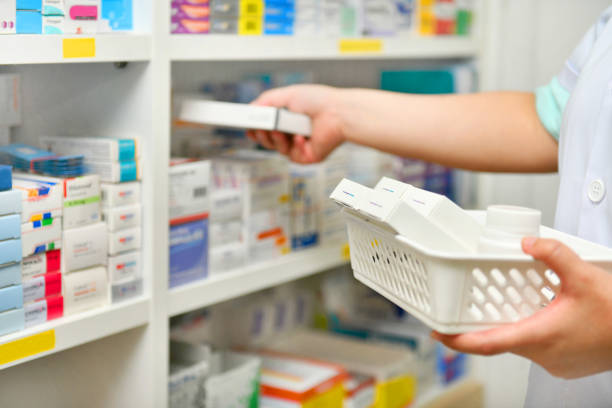High technology is changing the way pharmacies operate – and how customers get served.

Rowena the robot arm in action at Morningside Dispensary. Picture: Arthur Goldstuck
It looks like a normal pharmacy in a normal Johannesburg shopping mall. But behind the scenes at the Morningside Dispensary, a revolution is underway.
It may not be getting the attention that politicians get when they talk of the Fourth Industrial Revolution, but it is a real and practical example of what emerging technologies make possible in everyday life.
For the customers of this pharmacy are being served by a robot. Even when they don’t realise it, and are talking to a human pharmacist, the efficiency with which they are being served is made possible by a robot.
It doesn’t have a face or a cute voice: it’s a mere set of robot arms that manages the stocking and dispensing of medicines. The staff have given it a name, though: Rowena, after its creator, Rowa Technologies.
When a customer walks in, the pharmacist keys in the name of the medicine on a prescription and Rowa is able to find it instantly – among 20,000 boxes of medicine.
That means the pharmacist can carry on speaking to the customer while Rowena does the heavy lifting – or rather light lifting – and delivers the box of medicine into a basket behind the staff member. This means, in short, that the robot allows the human to be more human.
It is a perfect example of robots enhancing and augmenting human activity, rather than replacing human roles. The customer is served more quickly, even as the pharmacist engages more deeply with the person across the counter.
That makes the business as a whole more efficient, but also more human. Rowena also restocks the shelves, assisted by a conveyor belt and barcode scanner.
In the industry, they call Rowena an ADU, for automated dispensing unit. The first one in South Africa was installed in 2012 at the Pretoria Urology Hospital, now legendary for using robots to assist surgeons in operations.
“ADUs like the Rowa have been around since 1996,” says Jared Paiva, sales manager of DNA Logic, Rowa distributors in South Africa. “The first unit was installed in Germany, and they have been demonstrated in South Africa since 2008.”
He points out that robots are symbolic of digital technology making its way into pharmacies, with tools ranging from touchscreens to ATM pick-up units.
“All of these are tools for business to improve service, offer value and convenience to customers and create efficiencies for staff.
“ADUs solve many problems experienced in a pharmacy, such as staff shortages, long waiting times, stock theft, stock shrinkages, space problems.”
While Europe and rest of the world took to the technology immediately, with over 10,000 Rowa machines sold in 33 countries, he says, it is still a tough sell in South Africa, with just 18 units installed.
“That’s a good number considering how tough the economy has been. All 18 of our customers have seen the benefit of a Rowa almost immediately and wished they adopted the technology earlier.”
It is no surprise that service providers are emerging to take advantage of these technologies, trends and opportunities.
Right ePharmacy, a “strategic solution provider for the dispensing, distribution and collection of medicine” has introduced South Africa to the protocol data unit (PDU), an ATM using electronic and robotic technology to dispense medication. It is managed from the cloud, using Amazon Web Services (AWS) to take advantage of new capabilities and capacity as they are needed.
“The cloud-based information system hosts and manages patient data and links the patient to a remote pharmacist via an audio-video link,” says Fanie Hendriksz, managing director of Right ePharmacy.
“This virtual consultation between the patient and the pharmacist is called tele-pharmacy.
“Through AWS cloud, we were also able to implement a SMS system to keep users informed about their next collection dates and send out reminders. This promotes patient retention and assists the early identification and intervention for patients at risk of nonadherence. The system results in positive clinical outcomes and effective patient data management.”

Picture: iStock
PDU collection sites can be placed in communities at central, easily accessible locations, such as shopping centres on main transport routes. They can be kept open for extended hours, including weekends and public holidays, and patients can quickly and conveniently collect their repeat prescriptions.
Right ePharmacy isn’t just a great commercial idea. Its partners and funders include local and international agencies and teams committed to the prevention care and treatment of HIV, tuberculosis, cervical cancer and associated diseases.
Says Hendriksz: “Right ePharmacy is the centre of excellence for its parent company, Right to Care, spearheading disruptive innovation and enhancing differentiated models of pharmaceutical care in South Africa. We source, customise and implement the latest technology and systems to address key issues for better healthcare outcomes.
“The use of this pharmacy automation technology enhances delivery and access to medication services, eases overcrowding at facilities with high patient volumes, reduces patient waiting times and has the potential to improve medicine adherence and retention in care.
“Wider economic benefits are also achieved through minimising time off from work for employed PDU users.”
In effect, Right ePharmacy is bringing to the public sector the benefits of the Fourth Industrial Revolution that companies like DNA Logic offer the private sector.
“PDUs are primarily used to dispense chronic medication to patients, but they can be customised and utilised for specific programmes such as universal test and treat or malaria campaigns,” says Hendriksz.
“Right ePharmacy is the ideal partner for any form of key health initiatives such as treatment access scale up. The solutions also help to further address some of the structural issues in the public health sector, like inadequate skills and human resources.”
That’s not very different from the challenge facing commercial pharmacies, although on a much greater scale. The solutions are also not very different.
“We pioneered the customisation and installation of the first Pharmacy Automation Robotics system in the public sector. Currently, we have automated three hospital dispensaries with robotics in overburdened facilities.”
Clearly, the pharmacy of the future will be a case study in how robots come to the rescue of humans, rather than replacing them.

Picture: iStock
Coming next to a pharmacy near you
Rowena and Right ePharmacy are only the beginning of technology transforming the sector.
Jared Paiva, sales manager of DNA Logic, suggests three distinct categories we can expect in the near future:
• The adoption of other technologies for the future are remote dispensing, as this creates reliable access to essential and chronic medication, as well as a broader reach for the South African population. Furthermore, the technology will allow for reliable stock ordering to prevent stock depletion.
• More self-service and payment type of terminals in order to create value and convenience for clients, as well as online ordering and delivery from pharmacies. This will also open up the doors for remote pharmacist counselling.
• E-scripts (electronic scripts) will become widely accepted as more and more pharmacies move to paperless environments.
Fanie Hendriksz, managing director of Right ePharmacy, points to several new technologies that are ready to roll out:
• Customised collect and go electronic smart lockers that improve patient access and availability to pre-dispensed medication parcels. The lockers are temperature controlled, secure and conveniently located for ease of access to patients.
• The lockers are integrated with Amazon Web Services cloud-based technology which enables remote dispensing and live patient counselling. The cloud-based information system hosts and manages patient data and links the patient to a remote pharmacist via an audio-video link.
• An automated cloud-based SMS system keeps patients informed about their parcel tracking, next collection dates and sending of collection reminders. It uses a content delivery network called Amazon CloudFront, which assists the early identification and intervention for patients at risk of nonadherence. The system results in positive clinical outcomes and effective patient data management.
For more news your way, download The Citizen’s app for iOS and Android.






